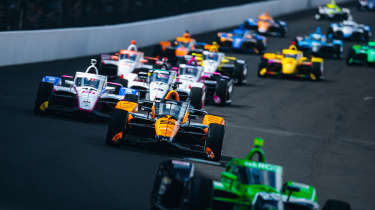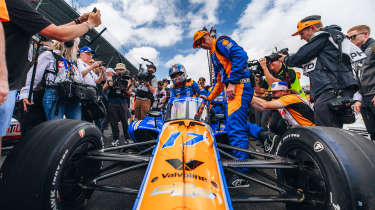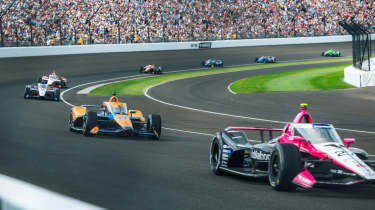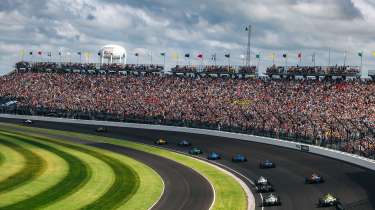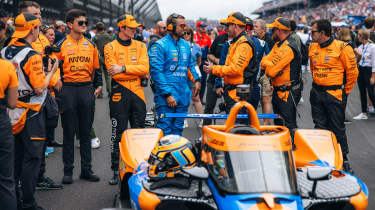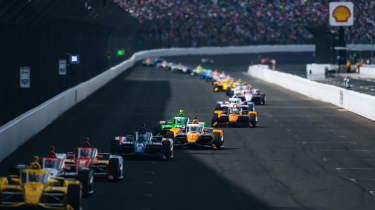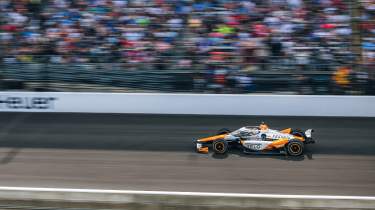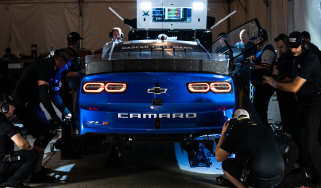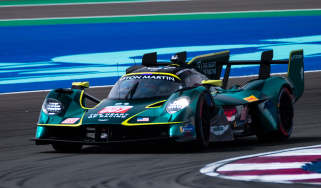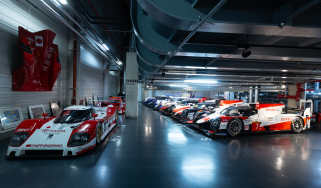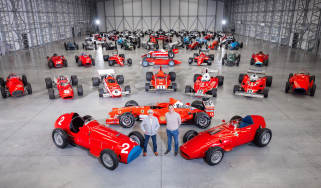Indy 500: behind the scenes of the iconic 240mph oval race
The Indy 500 is an event like no other. evo experiences it at first hand and goes inside the McLaren team as it comes achingly close to victory
One hundred and ninety-nine laps, 497.5 miles, nearly three hours of racing, and it all comes down to this: one lap and four corners stand between the Arrow McLaren IndyCar team and Indy 500 glory. It’s the 40th anniversary of McLaren’s first Indy 500 victory as a team, with Johnny Rutherford in 1974. Its last win in this race was in 1976. The team’s 25-year-old Mexican driver, Pato O’Ward, has been knocking on the door of an Indy 500 win for the last five years (and finished second in 2022). As the final lap begins, he sweeps past Team Penske rival (and last year’s winner) Josef Newgarden to take the lead. Four corners to go…
Rewind three days and 798 corners of racing: it’s Friday at Indianapolis, and the final day of practice. I’m here as a fly on the wall, to see the race through the eyes of the McLaren team – and to see what all the fuss is about. I’ve never been to the ‘Greatest Spectacle in Racing’ before, nor to an IndyCar race full stop. When I catch snippets of North America’s peak single-seater championship on TV and social media, it looks great: unpredictable racing on a mix of unforgiving street courses, traditional race tracks and ovals of varying lengths. Yet it’s a series I don’t actually know much about. I don’t doubt that some of you are in the same boat.
We all know the Indianapolis 500 is IndyCar’s biggest race of all, and although it’s Round 6 of the championship, it’s simultaneously an event in its own right; just as the Le Mans 24 Hour race is Round 4 of the World Endurance Championship but represents rather more than that. As with Le Mans and the Monaco Grand Prix (the latter taking place the same weekend as Indy), winning grants you sporting immortality. In fact the Indy 500 predates both Monaco and Le Mans: this is the 108th running. In terms of attendance, with a crowd numbering as many as 350,000, it’s considered the largest single-day sporting event in the world. Motorsport’s Super Bowl, but the entertainment isn’t reserved for half-time.
Tony Kanaan knows the 500’s highs and lows better than most – and the peculiar kind of immortality that comes with victory. ‘The first time I looked at this track I said: “These American people are crazy!”’ the 49-year-old Brazilian tells me. One of the most successful IndyCar drivers of all, he’s raced across multiple eras, winning the championship in 2004 and the 500 in 2013. His final 500 was last year; now he’s in a managerial and mentoring role as sporting director for the McLaren team. ‘It’s so technical and so difficult for something that looks so easy, because I know what people think: “They’re turning left twice – right?!” But once you fully discover it, it’s fascinating; completely different from anything else.’
A fan-favourite, his win in 2013 was a popular one. ‘I remember that day, every day. I built my trophy case so that I have to pass by my Borg-Warner trophy going downstairs to the kitchen every morning. And people remind me of it every day: when you do an appearance, when you talk to a journalist, they introduce you as the 2013 Indy 500 winner before they even mention your name.’
This final Friday before the race is ‘Carb Day’, named when Indy engines ran carburettors and needed final tweaks for ambient conditions. Today, the cars’ 2.2-litre twin-turbo V6s (supplied by two rival manufacturers, Chevrolet and Honda; McLaren is powered by the former), with outputs somewhere around 750bhp in Indy 500 tune, are fettled more with laptops than screwdrivers but the name sticks. The weight of tradition is lovingly draped over every aspect of the event.
Quali took place a week ago. It uses a four-lap average, rather than a single lap, and this year’s pole-sitter, Penske’s Scott McLaughlin, averaged 234.220mph – the fastest qualifying speed in Indy history. Team Penske locked out all three positions on the front row: they’re the team to beat. So they should be, one might think, given that team owner and industry titan Roger Penske owns both the Indianapolis Motor Speedway, and the IndyCar series itself – but that’s to underestimate the competitiveness and unpredictability of this series. ‘Anybody can win,’ emphasises McLaren’s pit stop manager, Kyle Sagan. ‘The racing is incredible; it’s just so good.’
The Indianapolis Motor Speedway is the only 2.5-mile ‘super speedway’ on the calendar. The cars reach 240mph on the straights in qualifying trim; even in the race they don’t spend much time below 220mph. ‘If you’re watching at home compared to being here, it’s so hard to get a perception of speed on the TV,’ Pato O’Ward explains ahead of Carb Day. ‘You’re going to be mind-blown by the speed of the cars: frickin’ fast.’
He’s not wrong. From the grandstands looking down on the track, the cars’ speed as they streak by, slipstreaming like shoals of fish in a speedbowl, is striking. At ground level in the pitlane (or Gasoline Alley, leaning into tradition) it’s more dramatic still. The energy as they flash by, a multi-colour blur just visible over the other side of the wall, is hard to put into words.
That’s something even Kanaan finds tricky: ‘Every year I’ve been around IndyCar I get asked to describe what it feels like. Every answer I’ve given in the last 20 years has been different – because you’re basically trying to describe something that’s indescribable. I can use comparisons like “Oh, you’re on a roller coaster” but you’re at 240 miles an hour! Yet, once you’re up there for three, four, five laps, it becomes slow,’ he adds, shaking his head. ‘You only truly realise again that you’re going so fast if you have to react to something, or you’re trying to slow down to come into the pit. It messes with your mind.’
‘It’s definitely not what you expect when you see it on TV,’ Pato O’Ward agrees. ‘On TV, sometimes it can seem a little boring. But the way you have to approach a pass, time the tow, set the car up – it’s so different to a road course where you can kind of manhandle the thing around. In an oval you need the car to help you; to do what you want it to do.
‘Indy is not very physical but it’s mentally draining because the room for error is so small,’ he emphasises. ‘You’re walking on a rope. On shorter ovals, oversteer moments are a bit more catchable. But here you’re just going so fast: if things go wrong, they really go wrong.’
It seems a childish question, but I ask it anyway: does he ever feel scared? ‘You have “oh shit” moments; when you’ve caught a slide where you’re like, “Oh my God, I don’t know how I did that.” But you just can’t be thinking about it. You have to be [in a] heightened [state]. That’s why your mind and your eyes get so tired by the end of the race. It’s so wearing.’
On race day the mood at McLaren is calm and cautiously confident. But before the scheduled start, torrential rain begins to hammer down. Grandstands are evacuated for fear of lightning strikes, and race start is delayed by four hours. Hurry up and wait. In the garages the team calmly begin building the separate cars for next weekend’s street-circuit Detroit Grand Prix – same Dallara chassis, but different almost everything else: engine, suspension, aero, even the stickers (Indy 500 cars have painted liveries rather than decals, because every little helps at 240mph).
All eyes are on McLaren in the paddock, where fans can get remarkably close. When the rain eases and the team’s four cars are pulled out of the garages to be warmed up, fans and their smartphones are only a few feet away. I doubt it’s quite the same over in Monaco. Despite its heritage, McLaren is a relatively young team in this guise: previously Schmidt Peterson Motorsport, McLaren Racing entered into a partnership in 2020 and took majority ownership after 2021. CEO Zak Brown is the team’s chairman and, notably, has chosen to be here at the Indy 500 rather than at the Monaco Grand Prix. Plenty of fans are wearing papaya orange shirts, and O’Ward is mobbed like a movie star whenever he appears.
Then, all of a sudden, it’s time. Brown assembles the team for a final pep talk with the four drivers: O’Ward, ex-F1 driver Alexander Rossi, regular WEC driver Callum Ilott and wildcard entry, NASCAR’s Kyle Larson, who has qualified a remarkable 5th on his IndyCar debut. Because the garages are separate from Gasoline Alley, the cars are towed to the grid behind pit-buggies and the team (and your wide-eyed correspondent, a few paces behind) walk with them, passing below the inner grandstands and into a cauldron of noise and energy the other side. It must feel like a gladiator stepping into an amphitheatre.
‘I remember watching a U2 concert, and the energy in the stadium,’ Tony Kanaan says. ‘When you look at those grandstands, full of 350,000 people, the energy, it’s the same feeling.’
I have no involvement other than as an observer, yet my heartbeat is hammering. Even Kanaan looks nervy: ‘I think it’s easier as a driver,’ he smiles ruefully, eyeing the team’s cars through the scrum of hangers-on (yours truly included) on the grid. I’m terrified at how close people’s feet are to the cars’ front wings; aerofoils that will shortly be slicing through the air at a couple of hundred miles per hour, drivers’ lives depending on them. Jets fly overhead, God Bless America and The Star-Spangled Banner are performed, and the grid is cleared.
I make it to the top of the grandstand on the inside of Turn 4 just in time for the start. The sheer volume of people is even more striking up here: every grandstand bordering the 2.5-mile oval is packed. When the field streaks away to Turn One, there’s a palpable wave of noise rippling in reaction around the stadium: there’s been a crash at the very first corner, a big one. Three drivers are out, happily without injury. And so begins the first of eight caution periods, the opening of a truly absorbing race. Cars gamble on different pit stop timings during the caution periods, strategic subplots within the wider 500 story. Some on-track passes are courteous and careful, drivers working together in the slipstream to further each other’s causes; some are firm and decisive as the occasion demands. It’s compelling, engrossing stuff. As the laps tick by, I hurry down to the pitlane, equally thrilled and disconcerted at how close my pass gets me to the action, within touching distance of pit crews grabbing tyres and leaping over the (unnervingly thin-looking) concrete wall for stops.
It’s thirsty work, and staying hydrated in the Indiana heat is crucial. ‘One of the things that’s different about IndyCar compared to, say, F1, is we don’t have a nice shaded garage to hang out,’ Kyle Sagan had told me before the race. ‘We’re out in the sun all day long, in your full fire-suit. It helps keep some of us pretty thin, that’s for sure.’ As does the pressure: ‘I’ve been to the Speedway when we’ve barely got through qualifying, and I’ve been lucky enough to win it in 2013 with Tony Kanaan, coming into the pits in first or second place, every time,’ he reflects. ‘The amount of pressure: it makes you old pretty quick. But that’s also part of the drive that keeps us coming back. To perform under that pressure, when you have those good days: there’s no feeling like it.’
This year McLaren is experiencing the full spectrum of fortunes. All four drivers lead at least one lap before race-end: Ilott suffers technical issues before the start, is caught up in the first-corner crash and later hit by another car in the pitlane, mounting a comeback to eventually finish 11th; Larson suffers car issues and a pitlane speeding penalty, finishing an unrepresentative 18th; and O’Ward saves just such an ‘oh shit’ moment as prophesied, catching two enormous slides at 220mph within the same corner (and creating a viral video in the process). But both Rossi and O’Ward slipstream their way through it all to the front of the pack. Pre-race, in the press conference, O’Ward said he was ‘happy to chill’ behind the leaders in the early laps. The important thing, experienced hands say, is to be in the top five with 50 laps to go. With 40-something laps remaining, that’s exactly where he and Rossi are.
And, one-hundred and ninety-nine laps down, two corners to go, O’Ward is in the lead. I’m watching from his pit box, his team pacing with nerves, bouncing on their heels with unbearable excitement, eyes glued to the screens. He goes as far left as he can on the back straight to break the tow, kicking up dust. But it’s not enough. Newgarden has momentum and passes him around the outside of Turn 3 at 220mph-plus. The Penske driver crosses the line of bricks first. O’Ward is second, Rossi fourth.
‘Hell of a drive,’ O’Ward’s crew tell him on the radio. ‘Hell of a drive, man. Sorry it didn’t work out there.’ Zak Brown is at his car when he reaches his pitbox, to console him. The emotion is palpable. Grown men in papaya firesuits have tears in their eyes as they quietly begin to pack kit away. O’Ward is slumped on the pit stand, yet to take his helmet off while TV crews patiently wait, microphones in hand, for a quote. Kanaan puts his arm around him. He’s been there. He understands. In polar-opposite contrast, Newgarden is drinking milk in Victory Lane, kissing the bricks at the finish line. More age-old tradition, more theatre.
I’m hooked. I had no idea what to expect and I’ve been captivated: by the fans, by the energy, and the racing too, which is both technical and genuinely thrilling. But I’m not sure I’d have felt the same watching the race remotely through a screen. Tony Kanaan says that he now, finally, has a stock answer when people ask him to describe how the Indy 500 feels. ‘You want to feel the Indy 500? Unfortunately, you have to come here.’ Now, I understand what he means.
